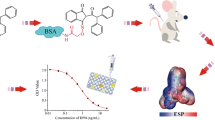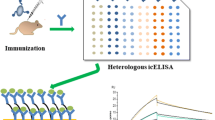Abstract
Copper ions are too small to elicit an immune response. Therefore, copper was conjugated to carrier proteins using S-2-(4-isothiocyanatobenzyl)-1, 4, 7, 10-tetraazacyclododecane-1, 4, 7, 10-tetraacetic acid, a bifunctional chelator, to make artificial antigens for copper. Several mice were immunized, and monoclonal antibodies (MAbs) against chelated copper were produced. Spleen cells of immunized mice were fused with myeloma cells. The resulting hybridomas were screened using protein conjugates which were covalently bound to metal-free 1, 4, 7, 10-tetraazacyclododecane-1, 4, 7, 10-tetraacetic acid (DOTA) or Cu-DOTA. Two hybridoma cell lines (F4 and B2) that produced MAbs with high selectivity and sensitivity were expanded for further study. Cross-reactivities with other metals were below 1%. These antibodies were used to construct competitive ELISAs for copper ions. The IC50 for F4 and B2 were 0.39 and 1.66 mg/l, respectively. The detection range and the lowest detection limit for copper using the antibody F4 was 0.019–8.22 and 0.003 mg/l, respectively. Spike recovery studies in tap water showed that the most sensitive antibody could be used for copper detection in drinking water.



Similar content being viewed by others
Abbreviations
- p-SCN-Bn-DOTA:
-
S-2-(4-Isothiocyanatobenzyl)-1 4, 7, 10-tetraazacyclododecane-1, 4, 7, 10-tetraacetic acid
- DOTA:
-
1, 4, 7, 10-Tetraazacyclododecane-1, 4, 7, 10-tetraacetic acid
- MAb:
-
Monoclonal antibodies
- BSA:
-
Bovine serum albumin
- KLH:
-
Keyhole limpet hemocyanin
- HAT:
-
Hypoxanthine aminopterin, and thymidine
- HT:
-
Hypoxanthine/thymidine
- FBS:
-
Fetal bovine serum
- OPD:
-
o-Phenylenediamine
- ELISA:
-
Enzyme-linked immunosorbent assay
- PEG:
-
Polyethylene glycol
- K a :
-
Affinity constants
- CR:
-
Cross-reactivity
- CI-ELISA:
-
Indirect competitive enzyme-linked immunosorbent assay
- ITCBE:
-
1-(4-Isothiocyanobenzyl) ethylenediamine N, N, N′, N′-tetraacetic acid
References
Blake DA, Jones RM, Blake RC II et al (2001) Antibody-based sensors for heavy metal ions. Biosens Bioelectron 16:799–809
Darwish IA, Blake DA (2001) One-step competitive immunoassay for cadmium ions: development and validation for environmental water samples. Anal Chem 73:1889–1895
Darwish IA, Blake DA (2002) Development and validation of a sensitive one-step immunoassay for determination of cadmium in human serum. Anal Chem 74:52–58
Khosraviani M, Pavlov AR, Flowers GC et al (1998) Detection of heavy metals by immunoassay: optimization and validation of a rapid, portable assay for ionic cadmium. Environ Sci Technol 32:137–142
Yu H, Jones RM, Blake DA (2005) An immunosensor for autonomous in-line detection of heavy metals: validation for hexavalent uranium. Int J Environ Anal Chem 85:817–830
Blake RC II, Pavlov AR, Khosraviani M et al (2004) Novel monoclonal antibodies with specificity for chelated uranium (VI): isolation and binding properties. Bioconjug Chem 15:1125–1136
Delehanty JB, Jones RM, Bishop TC et al (2003) Identification of important residues in metal–chelate recognition by monoclonal antibodies. Biochemistry 42:14173–14183
Reardan DT, Meares CF, Goodwin DA et al (1985) Antibodies against metal chelates. Nature 316:265–268
Zhu XX, Hu BS, Lou Y et al (2007) Characterization of monoclonal antibodies for lead–chelate complexes: applications in antibody-based assays. J Agric Food Chem 55:4993–4998
Zhu XX, Xu LN, Lou Y et al (2007) Preparation of specific monoclonal antibodies (MAbs) against heavy metals: MAbs that recognize chelated cadmium ions. J Agric Food Chem 55:7648–7653
Blake DA, Chakrabarti P, Khosraviani M et al (1996) Metal binding properties of a monoclonal antibody directed toward metal–chelator complexes. J Biol Chem 271:27677–27685
Jarrett BR, Gustafsson B, Kukis DL et al (2008) Synthesis of 64Cu-labeled magnetic nanoparticles for multimodal imaging. Bioconjug Chem 19:1496–1504
Xu Z K (1991) Practical monoclonal antibody technology. Shanxi
Pan XW, Zeng Y, Xu J (2003) The comprehension of preparation and purification of hybridoma ascites monoclonal antibody with BALB/c mice. J Shenyang Med Coll 5:123
Jones RM, Yu H, Delehanty JB et al (2002) Monoclonal antibodies that recognize minimal differences in the three dimensional structures of metal–chelate complexes. Bioconjugate Chem 13:408–415
Acknowledgments
This work was supported by the National “863” Project (2007AA10Z440 and 2007AA10Z426) of China and the National Natural Science Foundation of China (Nos. 30600441, 30230260, and 30871897).
Author information
Authors and Affiliations
Corresponding authors
Additional information
T. Kong X.B. Li, G.W. Liu, and G.H. XIE (Henan University of Science and Technology and Jilin University, respectively) contributed equally to this work.
Rights and permissions
About this article
Cite this article
Kong, T., Li, X.B., Liu, G.W. et al. Preparation of Specific Monoclonal Antibodies Against Chelated Copper Ions. Biol Trace Elem Res 145, 388–395 (2012). https://doi.org/10.1007/s12011-011-9206-7
Received:
Accepted:
Published:
Issue Date:
DOI: https://doi.org/10.1007/s12011-011-9206-7




